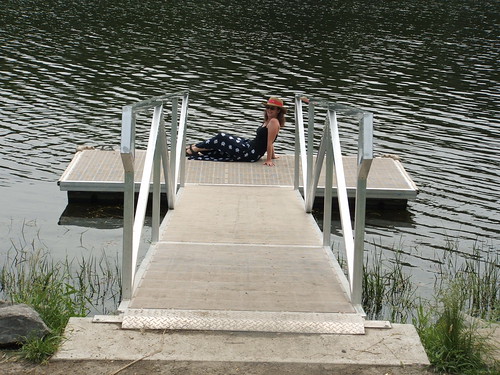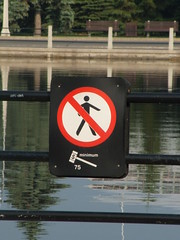It's time we reached some conclusions on our discussion of abortion. I wish to set the context for the discussion which follows by quoting, again, from
R. v. Morgentaler. Here, Justice Wilson advocates a developmental view of the fetus:
The undeveloped foetus starts out as a newly fertilized ovum; the fully developed foetus emerges ultimately as an infant. A developmental progression takes place in between these two extremes and, in my opinion, this progression has a direct bearing on the value of the foetus as potential life. …
Both traditional approaches to abortion, the so-called "liberal" and "conservative" approaches, fail to take account of the essentially developmental nature of the gestation process. A developmental view of the foetus, on the other hand, supports a permissive approach to abortion in the early stages of pregnancy and a restrictive approach in the later stages.
In the early stages the woman's autonomy would be absolute; her decision, reached in consultation with her physician, not to carry the foetus to term would be conclusive. The state would have no business inquiring into her reasons. Her reasons for having an abortion would, however, be the proper subject of inquiry at the later stages of her pregnancy when the state's compelling interest in the protection of the foetus would justify it in prescribing conditions.
Justice Bertha Wilson
This statement is remarkable, considering its source. Justice Wilson was the most liberal of the Supreme Court judges in her view of abortion.
(There were four sets of reasons given in
R. v. Morgentaler. Five of the seven judges agreed on the disposition of the case, but there was some disagreement with respect to the reasons they gave.)
Justice Wilson maintained, alone among her colleagues, that a woman has a constitutional right to abort a pregnancy. She deduced that right from a woman's right to liberty. The right to liberty is protected under the
Canadian Charter of Rights and Freedoms, but it is not absolute:
- The Charter is predicated on a particular conception of the place of the individual in society. An individual is not a totally independent entity disconnected from the society in which he or she lives. Neither, however, is the individual a mere cog in an impersonal machine in which his or her values, goals and aspirations are subordinated to those of the collectivity. The individual is a bit of both.
The Charter reflects this reality by leaving a wide range of activities and decisions open to legitimate government control while at the same time placing limits on the proper scope of that control.
So Justice Wilson argues that a woman has a constitutional right to abort a pregnancy; but that some degree of government control is nonetheless legitimate. The question, then, is this: "At what point does the state's interest in the protection of the foetus become 'compelling' and justify state intervention in what is otherwise a matter of purely personal and private concern?"
Take note of the word "compelling". It implies that the state has an interest in the protection of the fetus from the moment of conception; but, at such an early stage of the pregnancy, the state is not compelled to intervene on behalf of the fetus.
We ask, then, at what point does the state's interest become compelling? There are various possibilities, of course:
- conception (the traditional pro-life position);
- "quickening": i.e., when the pregnant woman can feel the fetus move inside her, approximately 16 weeks into the pregnancy (the view of English common law prior to 1803);
- sometime in the second trimester of the pregnancy (Justice Wilson's suggestion, deliberately vague, since she thought it was a matter for the legislature to determine);
- the point at which the fetus becomes "viable": at approximately 25 weeks' gestation (Roe v. Wade);
- birth (the point at which a fetus becomes a person, in Canadian law);
- some time after birth: e.g., after the baby's first breath or when the child is named (significant demarcations in some cultures).
This issue,
when does the state's interest in the protection of the fetus become compelling?, can be distinguished from the issue that usually dominates the abortion debate:
when does a fertilized ovum become a human being?
On the latter question, I am firmly in agreement with the pro-life folks. All demarcations are arbitrary, in my opinion, except one: conception. I am largely in agreement with Dr. John Stott, an elder statesmen in the evangelical church, on this point:
That an embryo, though carried within the mother's body, is nevertheless not a part of it, is … a physiological fact. This is partly because the child has a genotype distinct from the mother's....
It was only in the 1960s that the genetic code was unravelled. Now we know that the moment the ovum is fertilized by the penetration of the sperm, the twenty-three pairs of chromosomes are complete, the zygote has a unique genotype which is distinct from both parents, and the child's sex, size and shape, colour of skin, hair and eyes, temperament and intelligence are already determined.
Dr. John Stott
"Abortion" (pamphlet)
Dr. Stott overreaches on the last point; neither temperament nor intelligence is determined solely by one's genotype. But his general point is sound. The whole package is present, literally in embryonic form, from the instant the sperm penetrates the ovum.
In a society which puts so much stock in evidence derived from science, this position is virtually unassailable — or so it seems to me. At conception, we have a human being.
For Dr. Stott and other advocates of the pro-life position, this settles the matter. Abortion is morally repugnant and should be illegal. It may even be regarded as equivalent to murder, though I am not sure Dr. Stott would go so far. (If we wanted to recriminalize abortion, it could be placed in a different legal category — something akin to infanticide, for example — with lesser penalties.)
But the matter is not settled yet. There are two parties to every abortion: the fetus and the pregnant woman. Two human beings, if you will. Both the pro-choice camp and the pro-life camp try to exclude one party or the other from consideration. The goal, in my view, is to balance the interests of the two parties, however difficult such an analysis may be.
In the balancing exercise, we must seriously consider the developmental view of the fetus advocated by Justice Wilson. But there is another valid moral consideration: the degree of harm to which each party is potentially subjected.
What is the potential harm to the fetus (if society allows an abortion)? Death. What is the potential harm to the pregnant woman (if society refuses to allow an abortion)? The answer to this question is less obvious.
Inevitably there will be some inconvenience: some disruption to the course of the woman's life (e.g., education, career). If, after delivery, the woman gives the baby up for adoption, the inconvenience is confined to a short timespan. (Forty weeks, measured against approximately 75 years' life expectancy.)
Second, pregnancy has emotional consequences, not all of them negative: mood swings caused by hormonal changes, excitement, fear. In the case of an unwanted pregnancy, the fear will be greater and the woman may experience shame and/or embarrassment. A woman may permit the pregnancy to continue and then give the child up for adoption. That choice, too, will come at an emotional cost.
On this point (the matter of emotional consequences), I think there is merit in the position of the dissenting judges in the
Morgentaler decision:
- The mere fact of pregnancy, let alone an unwanted pregnancy, gives rise to stress. The evidence reveals that much of the anguish associated with abortion is inherent and unavoidable and that there is really no psychologically painless way to cope with an unwanted pregnancy.
Third, I would set post-partum depression in a category all its own. I am not very knowledgeable on this subject, but I suspect it has both a physical and an emotional component; and I know that, in severe cases, the woman may even become psychotic. The risk of such an occurrence is small but, if it comes to pass, the impact can be catastrophic.
Finally, pregnancy also has physical consequences: weight gain, stretch marks, the need to make responsible lifestyle choices for the good of the baby, etc.: and the pain of labour and childbirth. After the baby is delivered, the woman's body may be permanently changed in some respects. More significantly, there is a risk to the woman's health. The risk is usually small, but there is always some risk, even of death.
However, there are physical risks associated with having an abortion, too. To escape a risk associated with pregnancy only to embrace an approximately equal risk associated with abortion is of no net benefit to the woman.
In some cases, the pregnancy may present a higher risk to the woman, and society should take this into account. (As the Canadian legislature had attempted to do in the abortion law struck down in the
Morgentaler decision.)
My point is this. On the one hand, we must take Justice Wilson's developmental view of the fetus into account. At conception, the "fetus" is fully human (in my view). But, unlike the woman, it is not fully developed. Because of her position in life, the woman has social responsibilities (to parents, a spouse/partner, children, friends). She is emotionally sophisticated, subject to depression, shame, fear, etc.: i.e., she is capable of suffering and even misery. Even at the end of its gestation, the fetus has not reached a comparable stage of development.
On the other hand, the degree of potential harm is also a valid consideration. For the fetus, the consequence of abortion is death. (Pro-life advocates would say, half of the people who enter abortion clinics do not come out alive.) For the pregnant woman, an unwanted pregnancy is inescapably an ordeal (even if she chooses to abort it). But only in rare cases are there
catastrophic consequences of an unwanted pregnancy. (I believe this is an accurate assertion, though I do not have statistics to support it.)
These are the factors we must take into consideration if we set out to balance the interests of the two parties to an abortion.
At last, I will step out onto the thin limb. I offer the reader the following conclusions:
- I believe it is morally repugnant to carry out abortions after fifteen or sixteen weeks of pregnancy. I say this because of our earlier discussion of the instillation method of abortion: it is horrific, and it is used as of the 16th week. The very need to resort to the instillation method suggests that the fetus has developed to the point where it is, in fact, a baby. I think it is suggestive that this stage of development is reached at around the same time as the old common law standard of "quickening".
- If there is a serious risk to the woman's life or emotional welfare (e.g. evidence that severe post-partum depression is likely), I would allow a woman to abort at a later stage of pregnancy. I'm not going to suggest an administrative process by which requests for abortion, after 16 weeks, would be considered. It goes without saying that no process will be perfect. But a reasonable solution is surely possible.
- I am still ambivalent about the recriminalization of abortion, but on balance I favour it.
To pro-life groups, I would say this: it is not sufficient merely to say "No" to abortion. Abortion is a social problem, not to be reduced to the supposed sins of an individual, and we must address it by providing social supports for women in this position.
(Some pro-life groups don't need to be told. For example, I used to volunteer on the board of a residence for women in crisis pregnancies. The residence was an interdenominational Christian ministry. The women were trained in basic life skills and supported during pregnancy, childbirth, and for a short time after the birth. It was a highly constructive response to an issue that generates a great many purely negative responses.)
That said, I think social supports alone will be inadequate to discourage large numbers of women from choosing to abort. Some women (and their male lovers) will readily disregard the interests of the fetus. To a detached observer, death is obviously a more catastrophic outcome than inconvenience. But to a young woman who has limited life experience, who is afraid, who feels unsupported and sees her carefully-constructed plans going down the toilet — "inconvenience" may weigh heavily with her.
On balance, then, I support the recriminalization of abortion. Women would still be free to abort a pregnancy at will, provided that they do so prior to 16 weeks' gestation. After that, I would recriminalize abortion with the exceptions noted above.
A final comment, and I will invite the reader to respond.
Some people believe that men should have no say on abortion. I will share, as a post script, Justice Wilson's remarks on the subject. I find her position on this point offensive. Even so, I admit there is some merit to it. I want the reader to understand that I am aware of the issue and, on this point also, I invite your response.
This decision is one that will have profound psychological, economic and social consequences for the pregnant woman. The circumstances giving rise to it can be complex and varied and there may be, and usually are, powerful considerations militating in opposite directions. It is a decision that deeply reflects the way the woman thinks about herself and her relationship to others and to society at large. It is not just a medical decision; it is a profound social and ethical one as well. Her response to it will be the response of the whole person.
It is probably impossible for a man to respond, even imaginatively, to such a dilemma not just because it is outside the realm of his personal experience (although this is, of course, the case) but because he can relate to it only by objectifying it, thereby eliminating the subjective elements of the female psyche which are at the heart of the dilemma.
Justice Wilson
R. v. Morgentaler




















